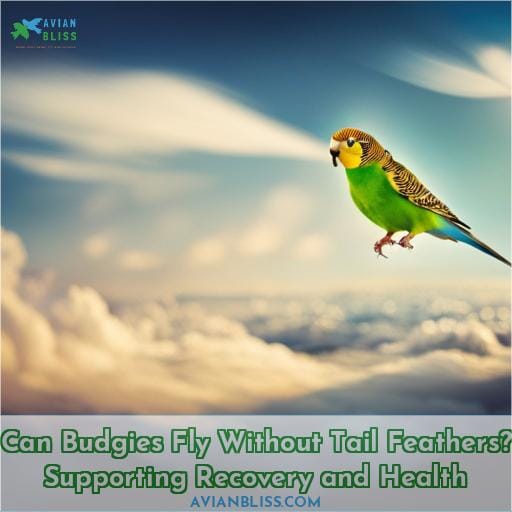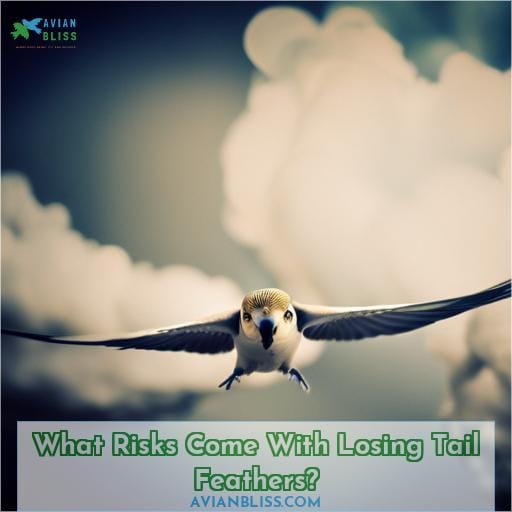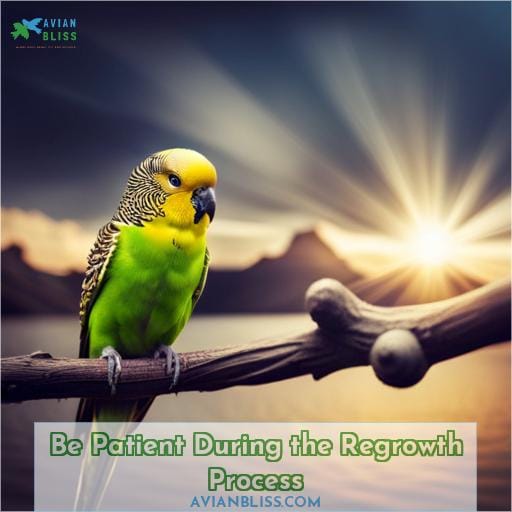This site is supported by our readers. We may earn a commission, at no cost to you, if you purchase through links.
 Got a budgie with a missing tail? Don’t panic. While tail feathers help steer mid-flight, budgies can still fly without them.
Got a budgie with a missing tail? Don’t panic. While tail feathers help steer mid-flight, budgies can still fly without them.
Focus on creating a safe environment as new feathers grow in. You’ll need to limit their flight time to prevent injuries from crashing.
Be patient through molting cycles and avoid stressors. With some adjustments, your tailless budgie can stay healthy and active until their feathers return.
Table Of Contents
- Key Takeaways
- Do Budgies Need Tail Feathers for Flight?
- What Causes Budgies to Lose Tail Feathers?
- How Does Losing Tail Feathers Affect Budgies?
- What Risks Come With Losing Tail Feathers?
- Supporting Your Budgie’s Health and Recovery
- Be Patient During the Regrowth Process
- Frequently Asked Questions (FAQs)
- Can budgies still fly without their tail feathers?
- How long does it typically take for budgies to regrow their tail feathers?
- Are there any special precautions or care needed for budgies without tail feathers?
- Can budgies still navigate and steer in flight without their tail feathers?
- Are budgies more prone to accidents or injuries when they don’t have tail feathers?
- Conclusion
Key Takeaways
- Budgies need their tail feathers for steering and flight control.
- Budgies can still fly without tail feathers, but it may affect their flight control and stability.
- Tail feather regrowth typically takes weeks to months, depending on the bird’s overall health and diet.
- Special care for budgies without tail feathers includes providing a safe environment, reducing stress, and seeking professional guidance.
Do Budgies Need Tail Feathers for Flight?
Two tail feathers serve as rudders that aid budgies in steering and flight control, so losing them can diminish stability and maneuverability during flight.
Tail feathers play a crucial role in the aerodynamic adjustments necessary for precise flight control.
When budgies lose their tail feathers, they face significant challenges in maintaining stable flights due to compromised agility and balance.
Without these essential appendages, budgies may struggle with coordinated movements mid-air, leading to potential accidents or injuries during takeoff or landing.
While alternative locomotion methods are possible through adaptation processes such as using wings for slight stabilization adjustments while flying short distances without tails, it isn’t an ideal long-term solution compared to natural flight capabilities with intact tail feathers.
Therefore, preserving the integrity of a budgie’s plumage is vital for ensuring optimal flight performance and overall well-being.
What Causes Budgies to Lose Tail Feathers?
Budgies can lose their tail feathers due to various reasons, including:
- Disease and infection
- Accidental injury
- Stress-induced behaviors
Diseases like PBFD or Polyomavirus can cause feather loss in budgies.
Accidental injuries during interactions or mishandling by humans may also lead to tail feather loss.
Additionally, dominance struggles between male and female budgies or plucking behavior can contribute to the problem.
Disease and Infection
Disease and infection are common factors that can lead to budgies losing their tail feathers.
To address this issue, it’s important to take preventive measures such as:
- Maintaining a clean environment
- Providing a balanced diet
Recognizing symptoms of disease or infection early on is crucial for prompt treatment options.
Consulting an avian vet is recommended for proper diagnosis and tailored treatment plans.
Additionally, stress reduction techniques should be implemented to support the bird’s overall health and recovery.
– Accidental Injury
Accidental injury is another common cause of tail feather loss in budgies, which can greatly impact their ability to fly and maneuver.
To prevent such injuries, it’s important to take preventive measures such as:
- Securing the cage when away
- Limiting unsupervised bird freedom
- Roommate communication is essential in avoiding mishandling or grabbing incidents.
- Safety precautions should be taken during interactions with inexperienced individuals to ensure the well-being of your budgie.
Feather regrowth will occur naturally over time with proper care and a conducive environment that promotes trust building between you and your pet bird.
– Stress and Behavior
When budgies experience stress and behavioral issues, it can contribute to the loss of their tail feathers.
Understanding dominance dynamics and recognizing stress signals is crucial for effective behavioral intervention.
Roommate interactions should be carefully monitored to prevent any accidental harm or stress-inducing situations.
Feather regrowth may occur once the underlying behavioral issues are addressed and resolved through appropriate interventions, creating a healthier environment for your budgie’s recovery.
How Does Losing Tail Feathers Affect Budgies?
Losing tail feathers can significantly impact a budgie’s flight ability and overall mobility.
- Flight control: Tail feathers serve as a rudder, providing stability and maneuverability during flight. Without them, budgies may struggle to maintain balance and control their movements in the air.
- Balance: Tail feathers play a crucial role in maintaining proper balance while perching or moving around. The absence of these feathers can make it challenging for budgies to navigate their environment with ease.
- Recovery: Budgies need time to recover from tail feather loss as they rely on regrowth for restored functionality. This process varies but usually takes weeks to months before new feathers fully develop.
- Regrowth complications: During the regrowth phase, complications such as ingrown or misshapen feathers may occur, further hindering flight abilities until resolved.
- Overall well-being: Losing tail feathers can cause stress and discomfort for budgies, affecting their overall health if not properly addressed.
Understanding how losing tail feathers impacts your beloved pet will help you provide appropriate care during recovery while ensuring optimal freedom of movement once they regain full flight capabilities.
What Risks Come With Losing Tail Feathers?
As your budgie loses its tail feathers, it’s important to understand the risks that come with this feather loss.
Without their tail feathers, budgies face an increased risk of injury and reduced flight mobility.
The absence of tail feathers can lead to potential complications during regrowth and hindered flight control, resulting in a reduced ability to maneuver effectively.
To illustrate these risks more clearly, let’s take a look at the following table:
| Risks of Losing Tail Feathers |
|---|
| Increased risk of injury |
| Reduced flight mobility |
| Potential complications |
| Hindered flight control |
| Reduced ability to maneuver |
These risks emphasize the importance of providing optimal care for your budgie during this period. Creating a safe environment with minimal hazards can help minimize the chances of accidents or further injuries while supporting their recovery process.
Supporting Your Budgie’s Health and Recovery
To support your budgie’s health and recovery after tail feather loss, it’s crucial to:
- Create a safe environment that minimizes stress and potential accidents.
- Focus on providing behavioral enrichment activities to stimulate their natural instincts.
- Consult with an avian veterinarian who can provide tailored advice for promoting optimal recovery and maintaining overall budgie health.
Create a Safe Environment
To support your budgie’s health and recovery, ensure a safe environment.
- Provide a spacious cage that allows for limited flight while keeping potential hazards at bay.
- This stress-free setting promotes healing and reduces the risk of further injury or stress-induced behaviors.
- Additionally, consider incorporating enrichment activities to stimulate mental and physical well-being.
- Consult with an avian veterinarian to tailor specific recommendations for your budgie’s needs during this crucial recovery period.
Focus on Behavioral Enrichment
With a safe environment established, prioritize activities and stimuli that encourage natural behaviors and mental stimulation for your recovering budgie.
- Provide plenty of cage enrichment like swings, ladders, and toys to keep your budgie busy and active.
- Rotate new perches, toys, and foraging activities frequently to prevent boredom.
- Allow supervised playtime and positive social interactions to reduce stress.
Consult an Avian Veterinarian
Your avian vet can tailor a specialized care plan for your budgie’s needs during recovery from tail feather loss.
Schedule a visit to address any underlying health concerns, get advice on potential treatment options for supporting regrowth, and establish an appropriate recovery timeline and follow-up care plan.
Stay patient as your budgie gradually regrows its tail feathers and engage with enrichment activities at home. But also follow your avian vet’s instructions to support healthy regrowth. Their expertise and understanding of your budgie’s needs makes them an invaluable ally during this recovery process.
Be Patient During the Regrowth Process
The natural timeline for tail feather regrowth varies among birds, but patience is key. Though the wait can be difficult, avoid undue stress or forcing growth. Your budgie needs time to recover properly.
Monitor their comfort level and provide enrichment during this period.
Regrowth happens gradually starting with the emergence of pin feathers. Be attentive but resist rushing the process.
With a stress-free environment and your gentle support, your budgie’s feathers can regrow in good time. Focus on their overall wellbeing, not just the tail, as you patiently aid their recovery.
Frequently Asked Questions (FAQs)
Can budgies still fly without their tail feathers?
Yes, budgies can still fly without their tail feathers.
While the tail plays a crucial role in flight control and stability, budgies can compensate with their wing feathers to maintain some level of mobility.
How long does it typically take for budgies to regrow their tail feathers?
Budgies can still fly without their tail feathers, but it may affect their flight control and stability.
Tail feather regrowth typically takes weeks to months, depending on the bird’s overall health and diet.
Are there any special precautions or care needed for budgies without tail feathers?
Yes, budgies can fly without tail feathers, but it may affect their flight control and stability.
Special care includes:
- Providing a safe environment
- Reducing stress
- Seeking professional guidance for tailored advice on supporting their recovery and overall health.
Can budgies still navigate and steer in flight without their tail feathers?
Without tail feathers, budgies’ flight control and stability are compromised.
While they can still attempt to fly, it becomes challenging for them to navigate and steer effectively.
Tail feathers play a crucial role in their aerial maneuverability.
Are budgies more prone to accidents or injuries when they don’t have tail feathers?
Yes, budgies are more prone to accidents or injuries when they don’t have tail feathers.
This is because tail feathers help budgies steer and navigate during flight.
Without them, budgies may lose their balance and crash.
Conclusion
Can budgies fly without tail feathers?
Yes, they can! While tail feathers are important for mid-flight steering, budgies can still fly without them.
It’s crucial to create a safe environment for your tailless budgie and limit their flight time to prevent injuries.
Additionally, providing behavioral enrichment and consulting an avian veterinarian can support their recovery and overall health.
Remember to be patient during the regrowth process, and with some adjustments, your budgie can stay healthy and active until their feathers return.









